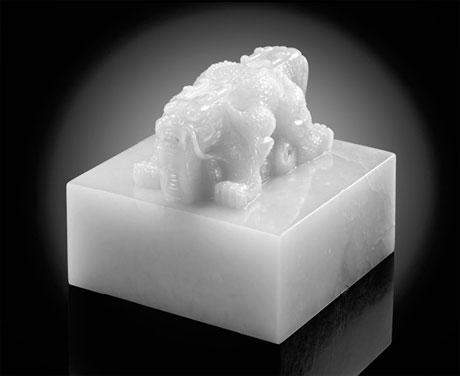Jade makes a very precious investment choice
Updated: 2011-01-28 06:54
By Bonnie E. Engel(HK Edition)
|
|||||||||

With the Year of the Rabbit in the Chinese calendar on its way, people gather plum blossom branches, fill lai see packets, and cook many traditional dishes for the family table in hopes of health, wealth and good luck.
They also give gifts. And none is more precious or meaningful than jade - whether in antique carvings, ornaments, screens, seals or precious jewelery. Collectors see it as an alternative investment too, as prices have been on the rise for fine quality pieces in recent years.
Modern Chinese people love jade. They buy bracelets to give to newborn babies, trinkets to dangle from their mobile phones, rings, necklaces and earrings and other forms of jewelery just for the love of these translucent, sensuous stones. Hong Kong, the mainland, Singapore, Taiwan and many other markets in Asia with ethnic Chinese populations have shops that sell or specialize in jade jewelery and other pieces, a testimony to its enduring popularity.
Jade jewelery is being offered by the major auction houses with increasing regularity, fetching higher and higher prices. Jade beads strung with other precious and semi-precious stones, including diamonds, are frequently seen in the finer jewelery stores around Asia. Some jade fans prefer the spinach greens, while others are fascinated with the white and other colored jades and build entire collections of one hue, mostly white.
How should one know what to buy? The neophyte collector needs first to know the difference between nephrite and jadite. Jadeite is the rarer of the two jade variations, and the most expensive. Most of the world's supply of fine jadeite comes from Myanmar, but deposits are found in Guatemala and a few other areas around the world. Jadeite did not reach China from Myanmar until the final third of the Emperor Qianlong's reign (1735-96), so jadite is relatively new to Chinese artisans. Most, if not all, the jade pieces and jewelery sold in Hong Kong today is jadeite.
Jadeite has a different structure than nephrite and has a glass-like translucency that was soon translated into jewelery and other pieces of personal adornment. Because so much jadeite is green, it is forgotten that jadeite occurs in many colors, including many variation of greens, plus white, lavender, pink, blue, grey, yellow, orange, black and shades of red, so color is not the only indicator of quality. Evenly colored, translucent emerald green jadeite is called Imperial Jade.
Talking to Edith Leung of Fortune Star Jewellery, a jewelery manufacturer and wholesaler, she said, "Modern Hong Kong jade sellers deal only with jadeite these days. Because it is not easy for most people to distinguish older jade from the newer and discern quality, we have an association, the Hong Kong Jade and Stone Laboratory, which will provide certification for the different jade treatments at the retail level. It is classified as types A, B or C, with A being natural Fei Cui that has not been subjected to any chemical treatment.
"Type B is chemically treated and resin added to the jade, whereas Type C refers to a stone dyed with a coloring agent. Type B+C has been chemically treated, has resin and is dyed."
She said that not many older pieces are available these days. There are a few antiques that may be 100 years old but people are beginning to prefer more modern pieces, especially in jadeite jewelery. The Xinjiang nephrite is used more for carving figures and ornaments, and is valued for its milky color. Being softer, it is easier to carve but all her jewelery designers only use Myanmarese jadeite.
Master carvers have turned to machines to do the carving, so some of the delicacy is lost. They are no longer making the large pieces unless jade of exceptional quality is found, such as extremely translucent pale green jadeite. Leung said Myanmarese jade is more transparent, and the white jadeite is called "ice" jade because you can nearly see through it.
"Hong Kong and mainland buyers all buy rings, pendants, earrings and necklaces, but the local people prefer the bright green jade while the mainlanders go for the more pale colors and translucence. Buyers need to check out the retailer's reputation and insist upon certificates, especially when the pieces are higher priced," she advised.
Jade designs with diamonds became more popular after World War II. She said the Taiwanese like the bigger pieces with diamonds and they like darker colors. Her shop sells to local shops or at exhibitions. She only makes 20-30 of most designs, and for the more complex pieces. They are one of a kind, so they retain their value. "Hollywood Road and Cat Street in Hong Kong are the places to go for antique jade, not the retailers", she added.
(HK Edition 01/28/2011 page2)